The Hiby FC4 offers a smooth and musical sound with excellent volume control.
Hiby is well-known as a portable audio device manufacturer. They started with USB DAC/amps and graduated to producing DAPs in different price brackets that are widely acclaimed by audiophiles worldwide.
I have had respect for Hiby for quite a while. And it began not with any of their sources but with a pair of IEMs, the Lasya. I got the R3 Pro Saber afterward, which was my trusted on-the-go partner for quite a while.
- Powerful output with low battery consumption
- Neutral to warm, laid back tonality, decent transparency
- Crispy notes with slightly rounded edges
- Comfortable sound with controlled and clean bass, organic mids, and clean treble
- Nice separation and airiness, impressive soundstage width and height, competent imaging
- Independent hardware volume control with volume memory
- Lightweight, sleek, and attractive build
- A bit too long
- Slightly lacking soundstage depth Lack of macrodynamics – making the sound sometimes boring
- The cable is a bit stiff
Hiby entered the portable DAC/amp sector with the FD1, following up with the FC3 dongle DAC/amp. The sub-USD $100 FC4 was released in 2022, and its massive power output and sleek design caught my attention immediately.
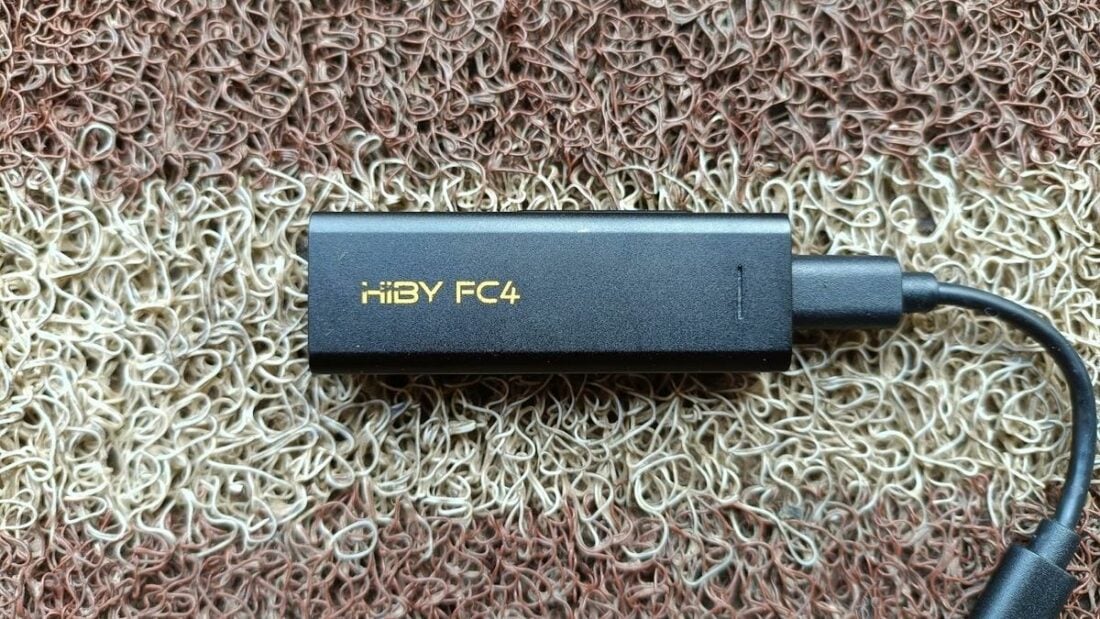
Technical Specifications
- Format: Portable DAC/amp
- Output Power: 110mW(SE); 340mW(BAL)
- Output Level: 1.9Vrms (32Ω SE); 1.9Vrms (32Ω BAL)
- Input Mode: USB Type C
- Output Mode: 3.5mm + 4.4mm Headphone
- Frequency Range: 20Hz-20kHz (32Ω)
- THD+N: 0.0008%(32Ω SE); 0.0006%(32Ω BAL)
- SNR: 120 dB (32Ω SE); 123 dB (32Ω BAL)
- Noise: 1.7μVrms (32Ω SE); 2.2μVrms (32Ω BAL)
- Crosstalk Rejection: 72 dB (32Ω SE); 98 dB (32Ω BAL)
- Playback Rate: PCM up to 32bit/768kHz, DSD up to DSD256, MQA 16x
- DAC Chipset: ES9219*2
- Material: Tin Alloy
- Device Weight: 21.7g
- Dimensions: 65.3*22.1*11.9 mm
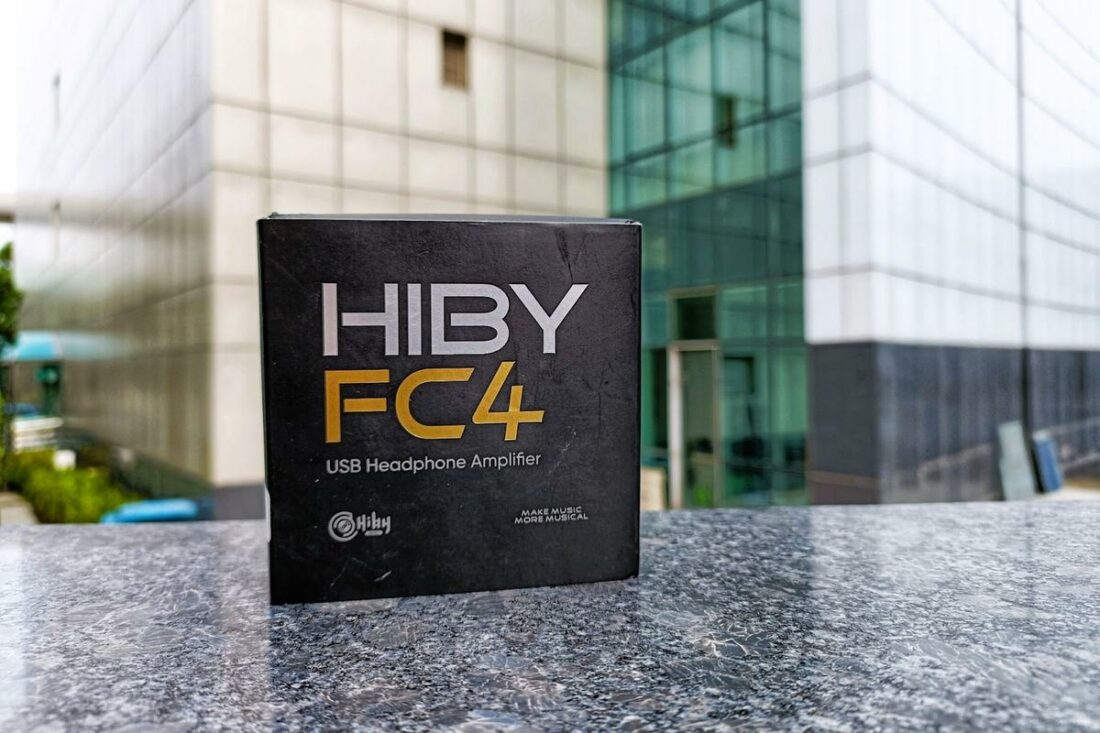
Packaging
The packaging of the FC4 is spartan. A tiny cardboard box (which is not exactly sturdy) contains all the accessories and the DAC/amp. The accessories are stowed away inside a separate small paper box.
In the box
- FC4
- USB-C to USB-C cable (120 mm)
- USB-C to USB-A cable
- User manual
- Warranty
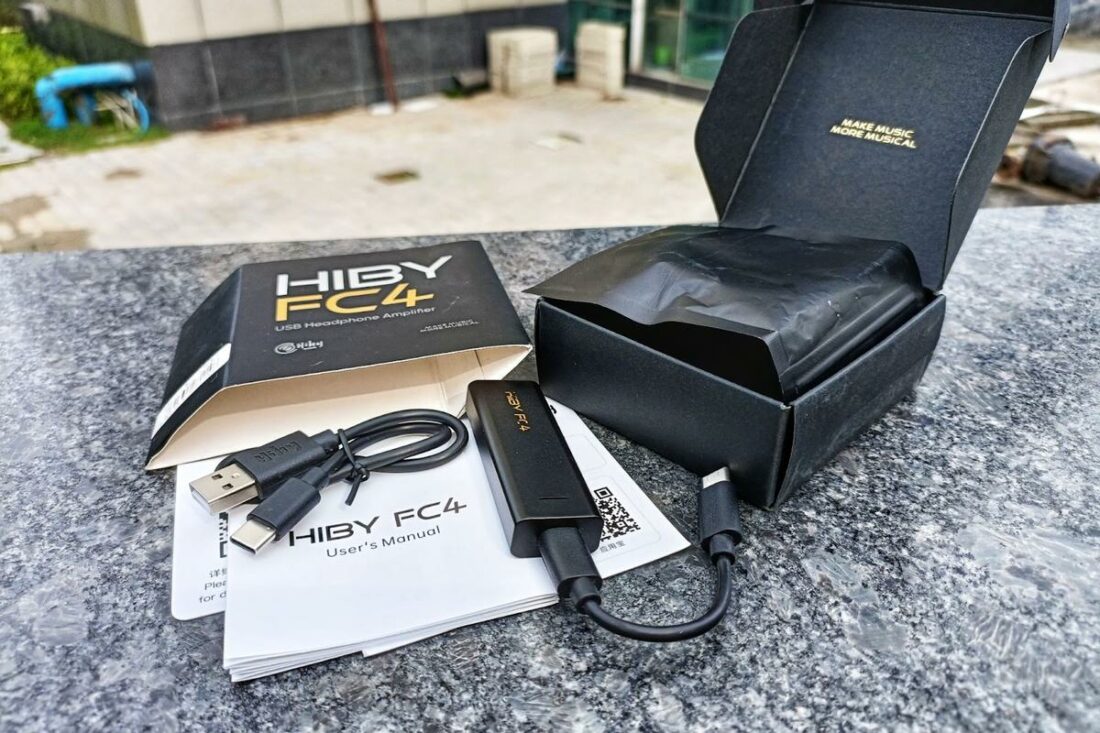
Design
The FC4 looks really classy. Absolutely minimalistic in a sleek rectangular design. The weight is surprisingly small compared to its size – making it easy to carry. The premium matte finish and rounded edges make it comfortable to handle.
As per the general norm, the 3.5mm and 4.4mm ports are on one short side, and the USB-C port is on the opposite side. One longer side has the clearly marked + and – volume buttons. A long LED indicator light is housed on the top.
The short USB-C to USB-C cable is of decent quality but a bit stiff. A more pliable cable would be better since it is meant to be used on the go. The USB-C to USB-A cable is of acceptable quality.
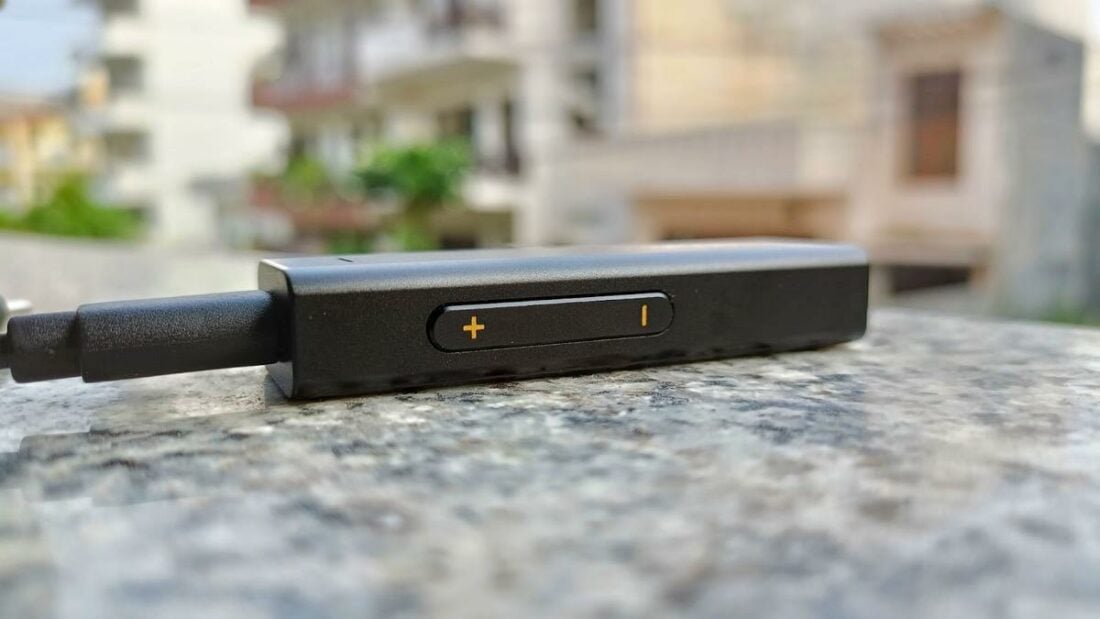
Internals
The main components of the FC4 are Dual ES9219 DAC chips from ESS. I came across this before in the Qudelix 5K, quite a wonderful DAC/amp, but the implementation was different.
The FC4 supports playback of PCM up to 768kHz/32bit, up to DSD256 files, and MQA unfolding up to 16x natively.
The 123 dB signal-to-noise ratio is quite impressive in this price range.
The FC4 is rated for a maximum output of 340mW @32ohms via the 4.4mm balanced output and 110mW @32ohms via the 3.5mm SE output. This is sufficient to power most IEMs and earbuds on the go.
The independent hardware volume control function makes the FC4 an instant favorite.
You do not see this feature often in this price range. It offers much greater control over the volume level and assures a more comfortable listening experience. The hardware volume function remembers the last volume level it was set at – another win for me.
LED indicator
The LED indicates the following:
- Red: Connected, not playing
- Yellow: Playing 32K-48K
- Cyan: Playing 64K-192K
- Orange: >352.8K
- White: DSD (64-256)
- Green: MQA
- Blue: MQA Audio
- Purple: MQA Core (MQB)
Battery consumption
USB dongle DAC/amps must minimize smartphone battery consumption to be sustainable.
I used the FC4 with my new Oppo Reno 7 5G(4500mAH), playing on-board 16/44 FLAC files, connected to a pair of 32 ohm earbuds. The FC4 consumed 3% of the phone’s battery over 20 min. Hiby’s claim of low power consumption seems to be valid.
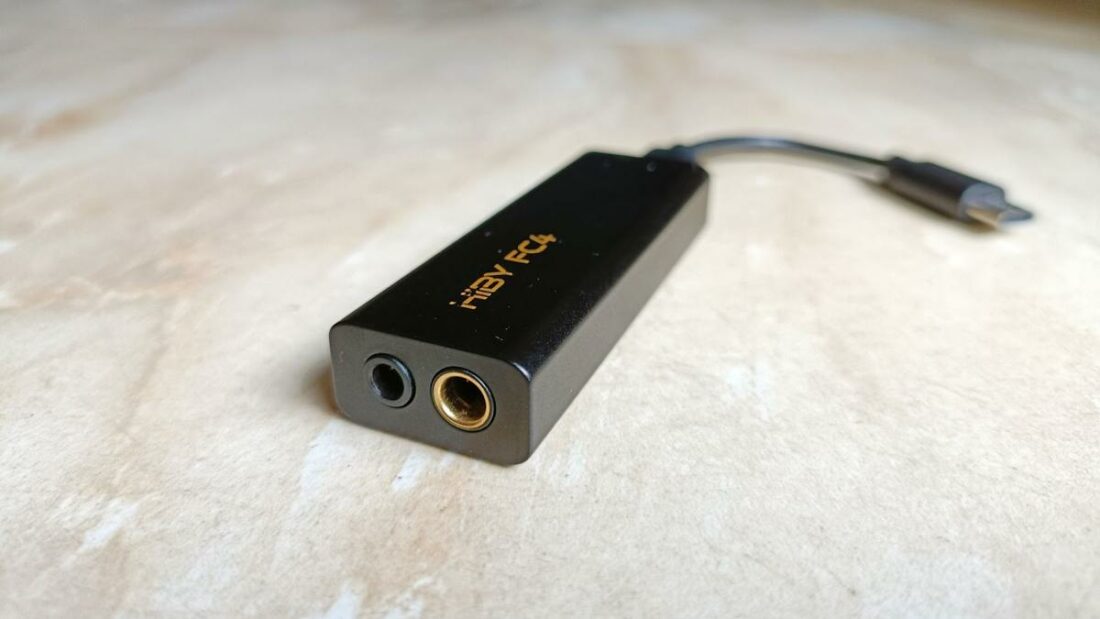
Sound
The FC4 presents the sound very refined and smoothly. It pulls off a laid-back tonality while preserving decent technicalities.
The FC4 does not surprise me with its sound. But one aspect that immediately stands out is how refined the sound is. There are no rough edges or boost in any section of the complete frequency range. The tonality does not tilt towards dark or bright, yet it never becomes boring.
The bass region is controlled but is not particularly scaled down. The midbass slams and sub-bass rumbles are reproduced well. The decay is natural, and details are not smeared. Textures are present but are not pushed forward.
Basslines and bass guitars sound sufficiently deep and textured. Drums sound punchy and fun. The notes do not lack body nor are overly full-bodied – just right.
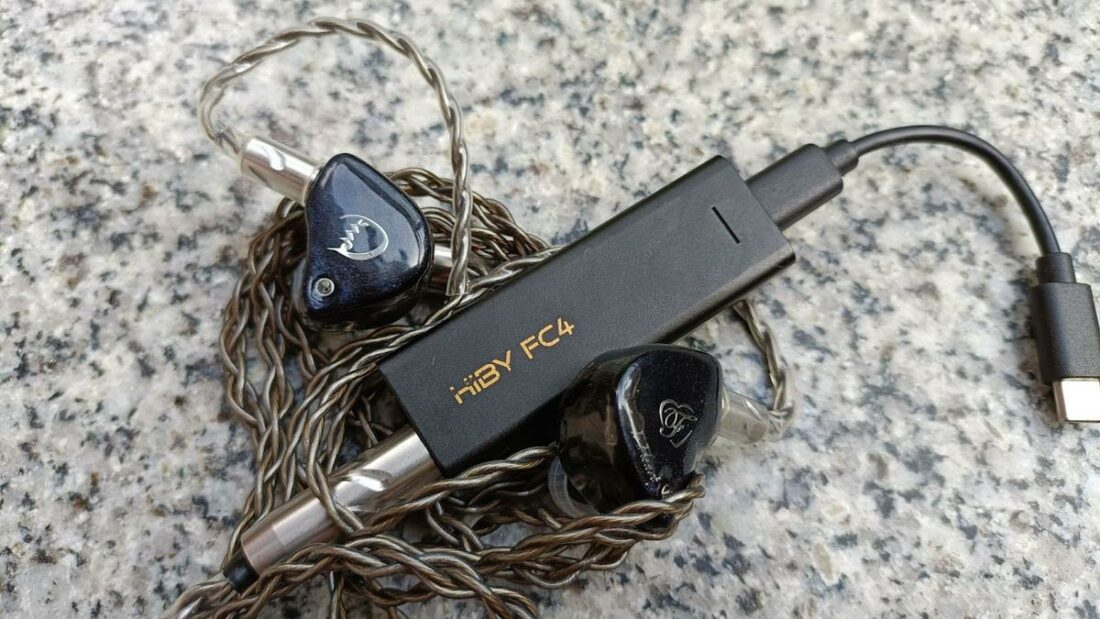
The midrange has decent transparency and a very lush tonality. The notes have somewhat smooth edges but also a crisp nature – the details are preserved despite the comfortable listening experience. There is a slight hint of warmth that elevates the overall musicality.
The lower midrange sounds quite rich. Male vocals, brass wind instruments, acoustic guitars, and cellos sound pleasantly full and organic. The upper midrange sounds amply vibrant but has the peaks under control – making even the coarsest vocals and sharp electric guitar riffs sound musical. Female vocals sound mellifluous and powerful.
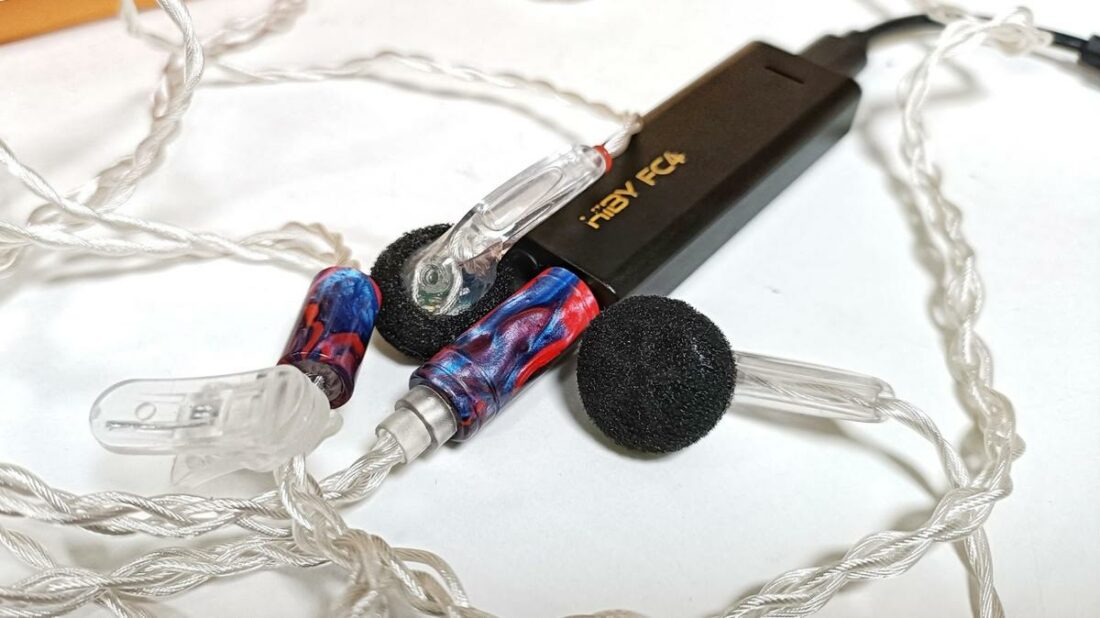
The treble representation of the FC4 is wonderful. While not pushed forward, this region still has abundant sparkle and brilliance. The notes have quite prominent textures, but they are not unnaturally enhanced.
Both the lower and upper treble have about equal amounts of energy. Cymbal strikes are quite prominent in the mix but never piercing. Hi-hat rolls have distinct shimmers. The upper treble extends well enough. The FC4 portrays this region with a deft finesse – clear yet reserved.
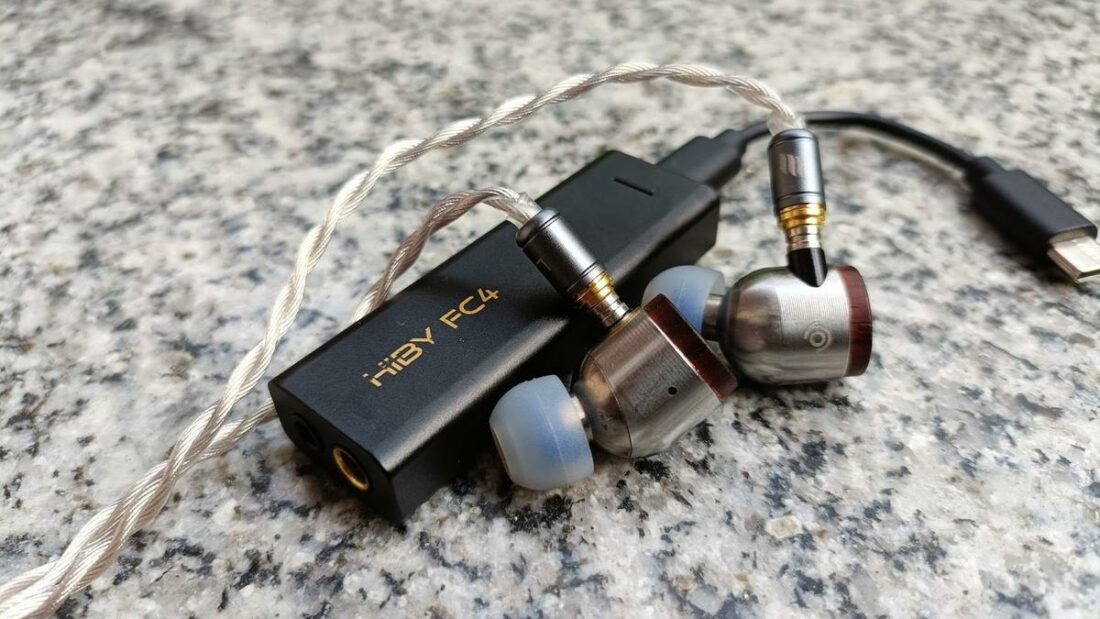
I find the FC4 technically quite capable. While it does not boost the details, it certainly reproduces them reasonably well while maintaining a smooth tonality. Textures are easy to pick up. The notes are crisp with slightly rounded off edges.
The soundstage extends well in width and height – slightly less in depth. The background is clean, and separation is acceptable. However, the laid-back tonality makes the microdynamics noticeably compromised.
The presentation is more refined than fun.
Comparison
Vs. Shanling UA3
An AK4493SEQ DAC chip and dual Ricore RT6863 amps power the Shanling UA3. It supports playback of DSD512 and PCM up to 32bit/768kHz. The LED status indicator indicates the file type, similar to the FC4.
The UA3 is shorter than the FC4 but is thicker, with a similar weight. The volume control buttons of the UA3 are larger with an additional play/pause button, which is a nice addition and functions as expected. But the volume buttons control the source volume, so the FC4 wins this round with its independent hardware volume control.
The UA3 sounds a bit smoother than FC4 but is also more dynamic. The background is darker. The stage is more spacious with more depth and width. Notes are a bit more rounded on the UA3 and it sounds more organic than the FC4. Treble has slightly more sparkle on the FC4.
Vs. Fosi Audio DS1
The DS1 is equipped with an ES9038Q2M DAC. It offers playback of 32-bit/384 kHz PCM and DSD512 files with sampling frequencies up to 5.6MHz. The small LED status indicator indicates the file type being played along with the power mode (low/high).
The DS1 sounds more dynamic and slightly raw compared to the FC4’s somewhat laid-back and more refined tonality. Please refer to my review of the DS1 for more details.
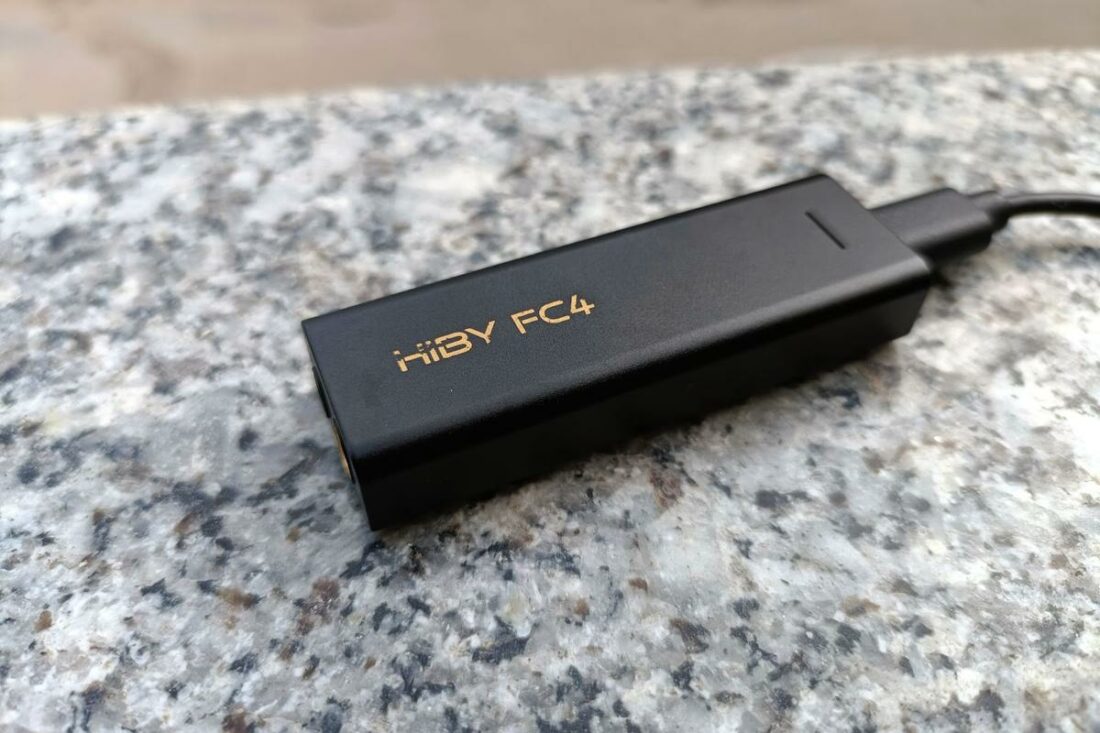
Where to Buy
Conclusion
The Hiby FC4 is a smooth operator. There are no flashy characteristics that will immediately amaze you. But, it most surely does its sole purpose efficiently – creating music.
Explicitly tuned as laid back, the FC4 dexterously preserves the technicalities within the music. Granted, the lack of macrodynamics may initially make the presentation sound less engaging. But with time, your ears will attune to its refined tonality. From there on, the FC4’s smooth yet clear personality will grow on you.
The other highlight of the FC4, besides its unique musical presentation, is the independent hardware level volume control and memory. This performs excellently and provides the freedom to choose the optimal volume. It also acts as the perfect source to compare IEMs or earbuds by maintaining equal loudness.
Hiby has excelled on both the technical and musical fronts with the FC4. They uphold their reputation of making music more musical with every product.
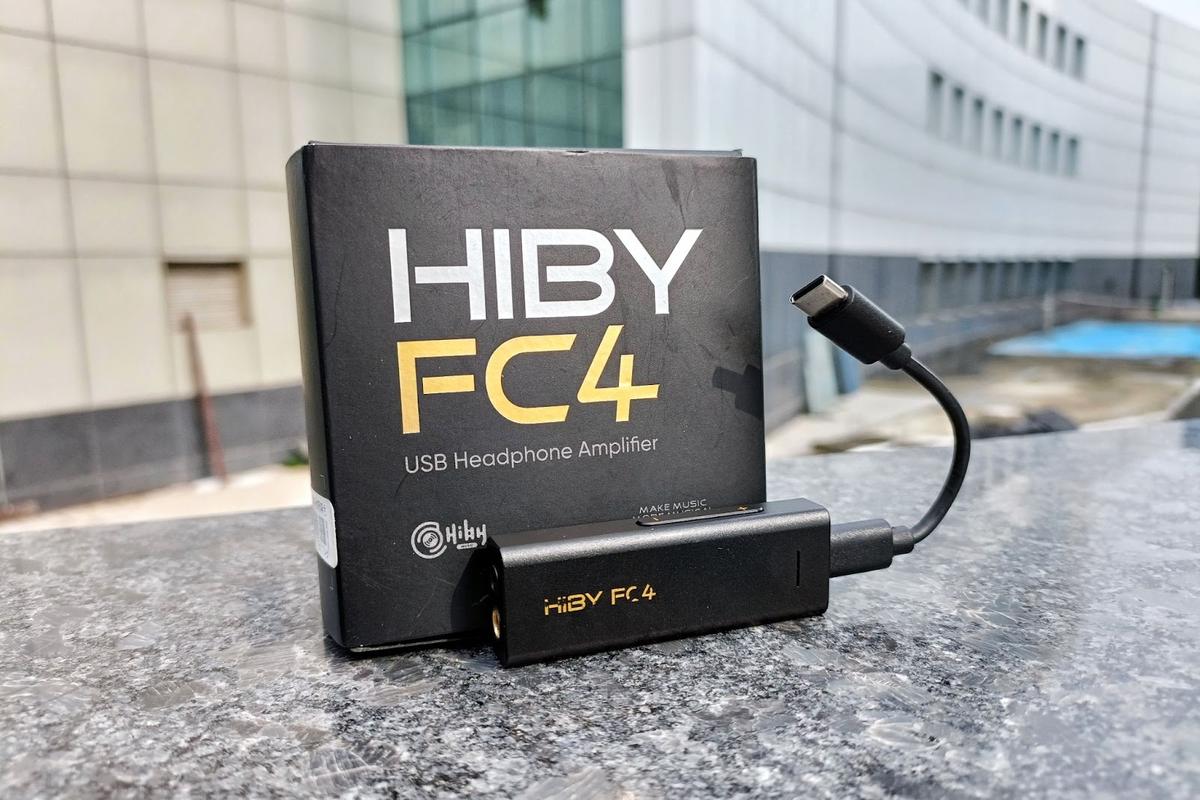
dear Ace Bee
All Fc4s sold after 01.2023 has DAC Chipset: ES9219*2 (before 12.2022 FC4s had ES9218)
and all those “new FC4s” with ES9219 are DEFECTIVE BY SOFTWARE
3.5 sounds average and 4.4 sounds not acceptable
they come(are sold) with stock firmware 1.08
and only if you update to firmware 1.12 you get some decent sound.
(and updating the firmware is not an easy job even for an expreinced enthusiast)
if your unit came with stock firmware 1.08:
HOW DID YOU REVIEW YOUR UNIT (WITH STOCK FIRMWARE WHICH MUST BE 1.08)?
HOW DID YOU FIND THE SOUND FROM 4.4 ACCEPTABLE?
it is quite misleading to review a defective product as if it is working properly. you are the second reviewer who reviewed fc4 as if it was normal sounding(the other review was on 02.2023 and with 1.08 for sure as 1.12 is only released lately)
(HIBY FC4 with stock firmware 1.08 sounds wierd not listenable/acceptable over 4.4)
HIBY FC4 updated to firmware 1.12 sounds:
u shaped. boosted bass giving warmth. very glary-flary (piercy) (upper)treble uncontrolled-scattered.
the warm character is more empahsized on 3.5 less so on 4.4
and my claims are not subjective or imho.
I received my FC4 in October 2022. I published my review much late. So it may be possible I reviewed an older unit. However, until and unless I can listen to a newer unit or your specific unit I cannot corroborate your statement. Hence my current impressions stand as of now.
Eroz is right. Every replacement I got was 1.08 as of October 2023. FW is not easy to update and takes some tricks. I only got it to 1.10 but it fixed the mono issue over balanced. Dfu tool required for 1.12 does not work on win10.